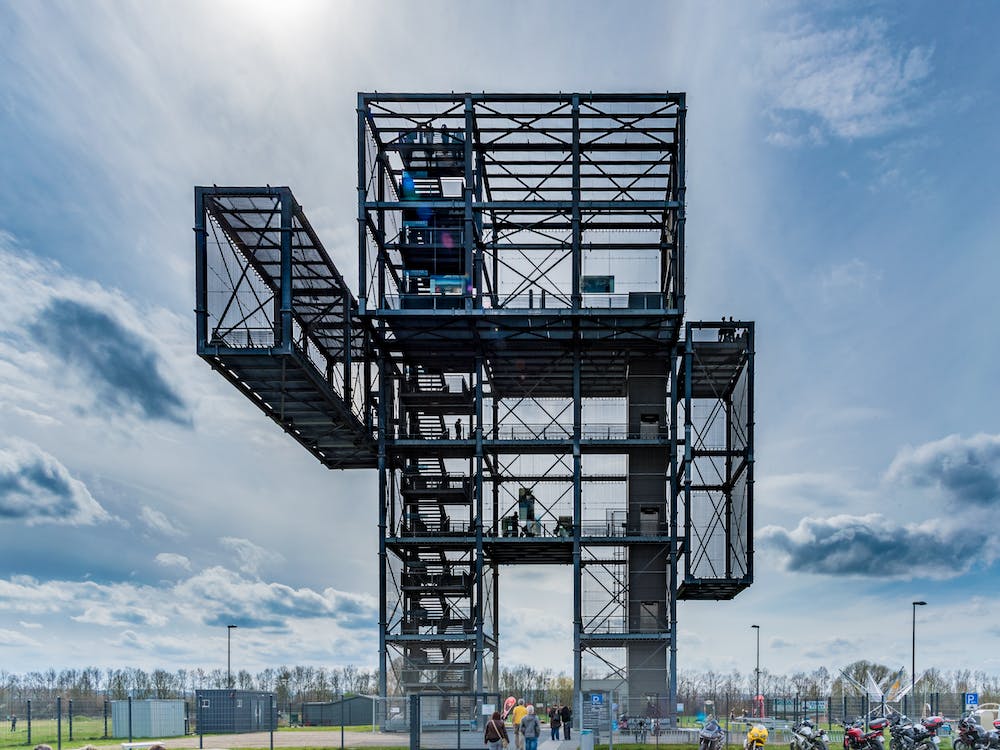The construction industry has long been known for its traditional methods and practices. However, in recent years, the advent of innovative technologies has revolutionised the way construction projects are planned, executed, and managed. From Building Information Modeling (BIM) to drones, robotics, and artificial intelligence (AI), advancements in technology are transforming the landscape of construction management, driving efficiency, productivity, and sustainability. In this blog, we explore some of the most impactful innovations in construction management and their role in enhancing efficiency in the construction industry.

Building Information Modeling (BIM)
Building Information Modeling (BIM) represents a groundbreaking advancement in the construction industry, offering a comprehensive digital representation of both the physical and functional aspects of building or infrastructure projects. Through BIM technology, construction managers gain the ability to develop highly detailed 3D models that not only capture the visual aspects of the project but also incorporate crucial information about design intricacies, materials specifications, component details, and construction processes. This level of detail enables construction managers to have a holistic view of the project, encompassing all its facets from inception to completion and even through maintenance phases.
The utilisation of BIM software equips construction managers with a powerful toolset to navigate the intricacies of project management with precision and efficiency. With BIM, construction managers can visualise the entire project lifecycle, from the initial conceptualization and design stages to the actual construction phase and subsequent maintenance requirements. The interactive nature of BIM models allows for real-time updates and modifications, ensuring that project stakeholders are always working with the most accurate and up-to-date information available. This level of transparency and collaboration fosters a synergistic environment where architects, engineers, contractors, and subcontractors can seamlessly collaborate, share insights, and address potential issues proactively.
Perhaps one of the most compelling advantages of BIM technology is its ability to facilitate seamless collaboration and coordination among project stakeholders. BIM models serve as a centralised repository of project data, providing a common platform for all parties involved to access and contribute relevant information. Architects can input design specifications, engineers can provide structural analysis, and contractors can offer construction sequencing insights – all within the same digital environment. This collaborative approach minimises the risk of miscommunication, reduces the likelihood of clashes or conflicts between different project elements, and ultimately enhances project efficiency by streamlining decision-making processes and minimising the need for costly rework.
Moreover, BIM technology empowers construction managers to go beyond traditional project management approaches by enabling them to simulate construction sequences and analyse potential impacts on project schedules and budgets. Through virtual construction simulations, construction managers can identify potential bottlenecks or conflicts early in the planning stages, allowing them to optimise construction sequences, allocate resources more efficiently, and mitigate risks to project timelines and objectives. This proactive approach to construction planning and management helps ensure that projects are completed on time, within budget, and to the highest standards of quality, ultimately enhancing project outcomes and delivering greater value to clients and stakeholders.
Drones
Drones, also referred to as Unmanned Aerial Vehicles (UAVs), have rapidly emerged as indispensable tools in the realm of construction management, heralding a new era of efficiency and innovation. Equipped with state-of-the-art technology including high-resolution cameras and advanced sensors, drones offer construction managers a unique vantage point, providing bird’s-eye views of construction sites and facilitating real-time monitoring and data collection. The ability of drones to capture detailed aerial images and videos of construction sites has revolutionised project oversight, offering construction managers invaluable insights into project progress, site conditions, and compliance with safety regulations.
One of the primary applications of drones in construction management lies in progress tracking and monitoring. Construction managers can deploy drones to conduct regular aerial surveys of construction sites, capturing comprehensive images and videos that document progress over time. By collecting this rich dataset and comparing it with project schedules and plans, construction managers gain the ability to assess progress against predetermined milestones, identify any deviations from the established plan, and implement corrective measures to ensure projects remain on track. This proactive approach to monitoring empowers construction managers to address potential issues promptly, mitigating risks and minimising disruptions to project timelines.
Furthermore, drones play a pivotal role in enhancing safety and security on construction sites, a paramount concern in the construction industry. Through aerial inspections, drones can swiftly identify potential safety hazards such as unsafe working conditions, equipment malfunctions, or instances of unauthorised access. By promptly identifying and addressing these issues, construction managers can preemptively mitigate risks and prevent accidents or injuries, fostering a safer work environment for all personnel involved in the project. Moreover, drones can be outfitted with cutting-edge thermal imaging cameras, enabling them to detect heat anomalies or leaks in building systems that may indicate potential risks or inefficiencies. By leveraging this technology, construction managers can enhance their risk management efforts and proactively address maintenance needs, ultimately bolstering the longevity and integrity of the constructed infrastructure.
In addition to their applications in safety and monitoring, drones offer construction managers a myriad of opportunities to improve operational efficiency and streamline workflows. For instance, drones can be utilised to conduct site surveys and inspections with unparalleled speed and accuracy, significantly reducing the time and resources required for traditional inspection methods. Furthermore, drones can assist in the inventory management process by providing real-time aerial views of construction materials and equipment, enabling construction managers to optimise resource allocation and minimise waste. Additionally, drones can be employed for environmental monitoring purposes, facilitating the assessment of ecological impacts and compliance with environmental regulations throughout the construction process.
In conclusion, drones have emerged as indispensable tools in the arsenal of construction managers, revolutionising the way construction projects are planned, executed, and monitored. From progress tracking and safety inspections to operational efficiency and environmental monitoring, drones offer a plethora of benefits that enhance project outcomes and contribute to the overall success of construction endeavours. As technology continues to advance, the role of drones in construction management is poised to expand further, unlocking new possibilities and driving greater efficiency and innovation in the construction industry.

Robotics
Robotics technology is revolutionising construction management by automating repetitive and labour-intensive tasks, improving productivity, and reducing reliance on manual labour. From bricklaying and concrete pouring to excavation and demolition, robots are being deployed across various construction activities to streamline operations and accelerate project delivery.
One of the most promising applications of robotics in construction management is automated bricklaying. Robotic bricklaying systems, equipped with advanced sensors and algorithms, can lay bricks with precision and speed far surpassing human capabilities. By automating this traditionally manual task, construction managers can significantly reduce construction time and labour costs while improving the quality and consistency of brickwork.
Robotics technology is being used to enhance safety and efficiency in hazardous or challenging construction environments. For example, robotic exoskeletons can assist workers in lifting heavy objects or performing repetitive tasks, reducing the risk of musculoskeletal injuries and fatigue. Similarly, robotic demolition systems can dismantle structures in confined spaces or hazardous environments, minimising exposure to safety hazards and improving worksite efficiency.
Artificial Intelligence (AI)
Artificial Intelligence (AI) is transforming construction management by enabling predictive analytics, optimization, and decision-making. AI algorithms analyse vast amounts of data collected from construction sites, equipment, and project management systems to identify patterns, trends, and insights that inform decision-making and improve project outcomes.
One of the key applications of AI in construction management is predictive analytics for project planning and risk management. AI algorithms can analyse historical project data, such as cost estimates, schedules, and performance metrics, to forecast project outcomes, identify potential risks, and recommend mitigation strategies. By leveraging AI-powered predictive analytics, construction managers can make more informed decisions, anticipate challenges, and proactively manage project risks to ensure project success.
AI is being used to optimise construction processes and resource utilisation. AI algorithms can analyse construction schedules, equipment usage, and material flows to identify inefficiencies and recommend optimization strategies. For example, AI-powered scheduling algorithms can dynamically adjust construction schedules based on real-time data, weather forecasts, and resource availability, optimising resource allocation and minimising project delays.
Virtual Reality (VR) and Augmented Reality (AR)
Virtual Reality (VR) and Augmented Reality (AR) technologies are revolutionising construction management by enabling immersive visualisation, training, and simulation. VR and AR systems create virtual environments that simulate real-world construction scenarios, allowing construction managers to visualise projects in 3D, identify potential design flaws, and explore alternative construction methodologies.
One of the key benefits of VR and AR in construction management is enhanced visualisation and communication. Construction managers can use VR and AR systems to create immersive virtual models of construction projects, enabling stakeholders to explore designs, evaluate spatial relationships, and provide feedback in real time. By visualising projects in VR or AR, construction managers can identify design conflicts, communicate design intent more effectively, and make informed decisions that enhance project outcomes.
VR and AR technologies are being used for training and simulation in construction management. VR and AR systems can simulate construction tasks and scenarios, providing workers with hands-on training in a safe and controlled environment. By immersing workers in realistic construction simulations, VR and AR systems can improve training effectiveness, reduce on-site errors, and enhance overall project safety and quality.
Innovations in construction management are driving efficiency, productivity, and sustainability in the construction industry. From Building Information Modeling (BIM) to drones, robotics, artificial intelligence (AI), and virtual/augmented reality (VR/AR), technology is transforming every aspect of construction project planning, execution, and management. By leveraging these innovative technologies, construction managers can optimise project workflows, enhance collaboration, improve decision-making, and ultimately deliver successful outcomes that meet or exceed stakeholder expectations in the fast-paced world of construction.
Embrace the future of construction with WunderBuild, a versatile construction management software that complements the innovative landscape of the industry. While technologies like BIM, drones, and AI are reshaping project execution and management, WunderBuild serves as the backbone for seamless project coordination and communication. It’s the perfect partner for modern construction professionals looking to harness the efficiency and productivity these advancements offer, ensuring projects are delivered on time and within budget. Discover here how WunderBuild can elevate your construction management experience in an era of technological transformation.



